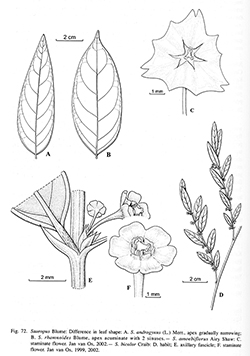e-Flora of Thailand
Volume 8 > Part 2 > Year 2007 > Page 527 > Euphorbiaceae > Sauropus
3. Sauropus androgynus (L.) Merr.wfo-0000304988
Philipp. Bur. For. Bot. 1: 30. 1903; Beille in Lecomte, Fl. Indo Chine 5: 645. 1927; Backer & Bakh.f., Fl. Java 1: 471. 1963; Airy Shaw, Kew Bull. 26: 333. 1972; Kew Bull. Add. Ser. 4: 193. 1975; Bergh in PROSEA 8: 244. 1994; Welzen, Blumea 48: 340, fig. la, map 3. 2003.— Clutia androgyna L., Mant. Pl. 1: 128. 1767. Fig. 72: A.
Accepted Name : Breynia androgyna (L.) Chakrab. & N.P.Balakr.
Bangladesh J. Pl. Taxon. 19: 120. 2012.
Synonyms & Citations :
Description : Shrub to treelet, up to 4 m high, glabrous, young branches with 2 or vaguely 4 ribs, without asperities. Stipules triangular, 1.8–3.2 by 0.8–1.3 mm. Leaves: petiole ca 2 mm long, flattened above; blade ovate, 1.8–9.1 by 0.8–4 cm, length/width ratio 1.5–2.7, papery (to pergamentaceous), drying greenish, base rounded to truncate, margin flat to recurved, gradually tapering (usually without a sinus) into the obtuse to acute apex, often mucronulate, green above, greyish-green underneath; nerves usually distinct on both sides, 6–10. Flowers in axillary fascicles, in small groups or on short, up to 8 mm long inflorescences, greenish to yellowish to (partly) red. Staminate flowers 3–18.5 mm in diam.; pedicel 4.5–13 mm long; calyx flat, small and lobed to wide, reflexed and hardly lobed, lobes indistinct to ovate, 0.7–3 by 1.3–5 mm, apices rounded, scales present; stamens: androphore 0.1–0.3 mm long, stamens 0.4–0.6 by 0.4–0.6 mm. Pistillate flowers 5.5–10 mm in diam.; pedicel up to 3.2(–14 in fruit) mm long; calyx lobes usually obovate, smaller ones 1.8–4 by 1.8–4.5 mm, larger ones 2.2–5.5 by 2–7 mm; ovary 1.1–1.5 by 1–2 mm; stigmas up to 1.2 mm long, flat, split till halfway, bend, forming less than a circle. Fruits white, inflated, fleshy, 14–16 by 9–15 mm; column 8–10 mm long with apically heart-shaped remnants of the septae. Seeds triangular in transverse section, hollow, 7–8 by 4.5–5 by 4–4.5 mm, white and black.
Thailand : NORTHERN: Chiang Mai, Nan; NORTH-EASTERN: Nong Khai, Mukdahan, Kalasin; EASTERN: Nakhon Ratchasima, Ubon Ratchathani; SOUTH-WESTERN: Kanchanaburi, Prachuap Khiri Khan; CENTRAL: Saraburi, Nakhon Nayok, Krung Thep Maha Nakhon (Bangkok); SOUTH-EASTERN: Prachin Buri, Chon Buri, Trat; PENINSULAR: Ranong, Surat Thani, Phuket, Nakhon Si Thammarat, Satun, Songkhla, Pattani, Narathiwat.
Distribution : From India and Sri Lanka to S China and Indochina, throughout W Malesia to Sulawesi, Maluku, and perhaps New Guinea.
Ecology : (Open areas in) shaded evergreen forests (with much bamboos), secondary forests, waste ground, fruit gardens, in scrubs, in old clearings, along river banks, edges of forests; soil: limestone, sand; 0–550 m alt.
Vernacular : Phak wan ban (ผักหวานบ้าน); kan tong (ก้านตง), cha phak wan (จ๊าผักหวาน)(Northern); tho-lui-ka-ni-do (โถหลุ่ยกะนีเด๊าะ)(Karen-Mae Hong Son); phak kan tong (ผักก้านตง)(Northeastern); phak wan (ผักหวาน), ma yom pa (มะยมป่า)(Prachuap Khiri Khan); phak wan tai bai (ผักหวานใต้ใบ)(Satun); na-na-siam (นานาเซียม)(Malay-Satun).
Uses: Young shoots, leaves, but also flowers and fruits can be eaten as a vegetable, raw or cooked; they taste sweet and have a nice or very typical odour. They can also be added to soup. The dried and crushed root is used medicinally in Chiang Mai against headache, but seemingly it also acts against fever or urinary problems; the leaves are thought to stimulate milk production and recover the womb after child birth.
Notes: 1. Almost similar to Sauropus garrettii (latter with very small asperities on stems and petioles) and S. rhamnoides (larger leaves, pistillate sepals thicker, stigmas larger).
2. Sauropus sp. (Airy Shaw, 1972) is referred to S. androgynus, because staminate flowers with distinct, incurved lobes are often encountered.

